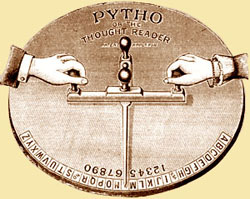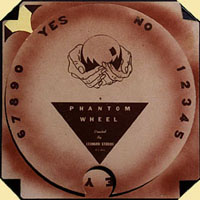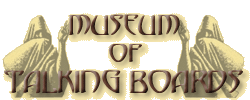
Today, we might consider a kitchen table a peculiar piece of equipment to use to speak with spirits. For the spiritualist mediums of the 1850's, it seemed quite natural. A table was an available and commonplace piece of household furniture and a natural gathering place for family members. It also provided an ideal contact surface for those performing a séance. It worked very simply: the sitters placed their hands palms down on the tabletop and asked questions of the spirits. The spirits responded by tilting the table and rapping a leg against the floor. One knock meant, "no," two knocks meant, "doubtful," and three knocks meant, "yes." For complicated messages, spiritualists either called out the alphabet and let the spirits knock at the appropriate letter, or they employed an alphabet pasteboard. A member of the group held up the pasteboard with one hand, and with the fingers of the other, passed them slowly over the letters. The spirits knocked when the fingers touched the desired letter. Although somewhat time consuming, it was a simple and effective way to spell out messages from the "Dearly Departed."
Some mediums believed that there might be better methods of interpreting messages than using tables and alphabet boards. Modeling their equipment after the new dial plate telegraphs of the period, the logic was plain: if you could contact the living using the telegraph, then why not the non-living? In 1853, a Thompsonville, Connecticut spiritualist, Isaac T. Pease, called his invention, suitably enough, the "Spiritual Telegraph Dial." Just a dial with letters arranged around the circumference and a message needle to point to them were necessary. There was no need for messy wires or electricity.
Not everyone thought that speaking with the dead was a great idea. The religious community cried heresy and called communicating with spirits "necromancy." Scientists labeled the entire spiritualist movement a "popular delusion" and concluded that the motion of the table was due to the unconscious muscular actions of the participants and not "spirits." In 1853, one scientist devised a series of investigations and determined to put the matter to rest, once and for all.
 Robert Hare, M.D., age 72, was an
emeritus professor of chemistry in the University of
Pennsylvania, a graduate of Yale College and Harvard
University, and associate of the Smithsonian
Institute. He was also a member of "various learned
societies." Add to that his invention of the
oxy-hydrogen blowpipe and authorship of over 150
papers on scientific subjects and it is hard to
imagine a man more qualified to ferret out the truth.
It was "an act of duty to his fellow creatures to
bring whatever influence he possessed to the attempt
to stem the tide of popular madness which, in
defiance of reason and science, was fast setting in
favor of the gross delusion called spiritualism."
Using his scientific acumen, Hare designed his
experiments specifically to expose table tipping as
the flimflam he was certain it was. Apparently, his
investigations worked in a way unintended. Hare
became an ardent believer in spiritualism.
Robert Hare, M.D., age 72, was an
emeritus professor of chemistry in the University of
Pennsylvania, a graduate of Yale College and Harvard
University, and associate of the Smithsonian
Institute. He was also a member of "various learned
societies." Add to that his invention of the
oxy-hydrogen blowpipe and authorship of over 150
papers on scientific subjects and it is hard to
imagine a man more qualified to ferret out the truth.
It was "an act of duty to his fellow creatures to
bring whatever influence he possessed to the attempt
to stem the tide of popular madness which, in
defiance of reason and science, was fast setting in
favor of the gross delusion called spiritualism."
Using his scientific acumen, Hare designed his
experiments specifically to expose table tipping as
the flimflam he was certain it was. Apparently, his
investigations worked in a way unintended. Hare
became an ardent believer in spiritualism.
In his 1855 book, Experimental Investigation of the Spirit Manifestations, Hare details his experiments and the strategies he contrived to prevent mediums from using trickery or unconscious muscular actions while communing with the "Invisibles." Taking Isaac T. Pease's "Spiritual Telegraph Dial" he added elaborate pulley and wheel devices with weights and cables and he placed barriers directly in the mediums' line of sight so that they were effectively blind during a séance. Hare called his instruments "Spiritoscopes." Here is one surviving example, (above right, courtesy James Bostelle) and Hare's comprehensive description:
"It is in the substitution of a small board for a table that the principal difference consists. The board requires only to be large enough to allow the hands to rest upon it in front of the disk. The index is actuated by a horizontal motion to and fro, which causes the rotation of a supporting wheel, which by means of a band communicates rotation to a pulley supported behind the disk on the pivot to which the index is secured in front. The sliding pulley being fastened at a due distance from the disk, is used to keep the band tight. This instrument is preferred by the spirits, and is easier for a feeble medium to employ effectually. Through [this board] I have had some interesting tests. This form, then, is best for incipient mediumship. It may be employed under test conditions, by so situating it as that the dial shall be on the side opposite to that where the medium sits; under these circumstances she cannot see the index or the letters, and consequently cannot control the spelling of spirits, so as to give results from her own mind instead of theirs. This mode of testing does not preclude the subterfuge, so often resorted to, of clairvoyant power, enabling the medium to see through the cast-iron, or read the letters in the minds of the bystanders. This power I have never witnessed; yet it is absurdly attributed to media who, as well as all their friends, are ignorant of the existence of any such power."
The professors at Harvard University were not amused by Robert Hare's conversion to spiritualism and what they referred to as his "insane adherence to a gigantic humbug." He departed disgraced and embarrassed, but not beaten.
Despite academia's refusal to accept Robert Hare and his experiments, spiritualism and spiritualistic devices flourished in the United States and Europe. In England, an early dial plate instrument received a patent. In France, spiritist Allan Kardec (Léon-Dénizarth-Hippolyte Rivail), the founder of French Spiritism, published his 1861 book, Le Livre des Mediums. In it, he describes his own experiences with the dial plates (translated by Anna Blackwell):
"In order to render spirit communications independent of the medium's mind, various instruments have been devised. One of these is a sort of dial-plate, on which the letters of the alphabet are ranged like those on the dial of the electric telegraph; a movable needle, set in motion through the medium's influence, with the aid of a conducting thread and pulley, points out the letters."
"A more simple contrivance, is the one devised by Madame Emile be Girardin, and by which she obtained numerous and interesting communications. The instrument alluded to, consists of a little table with a movable top, eighteen inches in diameter, turning freely on an axle, like a wheel. On its edge are traced, as upon a dial-plate, the letters of the alphabet, the numerals, and the words "yes" and "no." In the centre is a fixed needle. The medium places his fingers on this table, which turns and stops when the desired letter is brought under the needle. The letters thus indicated being written down one after the other words and phrases are obtained, often with great rapidity. It is to be remarked that the top of the little table does not turn round under the fingers, but that the fingers remain in their place and follow the movement of the table."

The instruments Allan Kardec referenced lacked the complexity of Hare's inventions and, being a believer, Kardec made little effort to ascertain whether his mediums were cheating. These dial plates were simple rotating discs, like a record turntable, that moved under the touch of the medium's fingers. And there were variations on a theme (see Pytho or the Thought Reader, left) with stationary discs and movable pointers. Few of these devices survived to modern times. Early descriptions, patents, and a few remaining examples, are all we have to go on.
Although the dial plate
instruments—or psychographs (see Hudson Tuttle), as they were
commonly called, never experienced the mass appeal of
the Ouija type boards, there are a few modern
equivalents. Leonardi Studios' 1966 Phantom
Wheel, (right) is such an example. There were
also some peculiar variants that were neither here
nor there. The most unusual might have been Milton
Bradley's 1895 odd oak contraption, Genii, The Witches Fortune
Teller. The Genii consisted of two
boards sandwiched together. The top board slid back
and forth to reveal letters through a
peephole.
An early British version was this Telepathic Spirit Communicator (below, left) produced by Two Worlds Publishing. The wheeled message indicator moved along a track to spell out messages. Perhaps more interesting than the board are the detailed instructions printed on the lid of the box. Directions from most manufacturers were lamentably short and vague, a complaint heard even today. Not so with this one:
"When sitting for investigation
into the subject of Spirit Return, try to take all
possible precautions against outside interference.
Quietude is a valuable aid. Place the fingers of one
or both hands lightly on the Board, and sit passively
until movements take place. When that occurs, ask the
unseen operators to try to spell out a name or
message. Should your first attempts result in
failure, do not get discouraged. A sit often requires
a few sittings before the power can be sufficiently
controlled to ensure reliable results. Take care that
mistakes do not occur on your part and always
remember that errors are quite possible on the part
of the communicator. Spirits are only human beings,
and do not possess more knowledge or goodness than
they have acquired by their own efforts, and if any
should try to impose upon you chasten them
kindly. Ignorant spirits will sometimes
attempt to flatter and deceive. Always exercise
judgment and discretion concerning all messages
received. Be kind and sympathetic towards your unseen
communicators. They may need your friendship. To
obtain the best results, maintain a tranquil
condition of mind and cultivate a habit of sincerity
and honesty. You should not sit more than an hour at
a time, and not oftener than twice a week. Two
persons can use the instrument by placing one hand
each lightly upon the board. After a little practice
the person sitting at the board may be blindfolded, a
second person recording the messages."
Ignorant spirits will sometimes
attempt to flatter and deceive. Always exercise
judgment and discretion concerning all messages
received. Be kind and sympathetic towards your unseen
communicators. They may need your friendship. To
obtain the best results, maintain a tranquil
condition of mind and cultivate a habit of sincerity
and honesty. You should not sit more than an hour at
a time, and not oftener than twice a week. Two
persons can use the instrument by placing one hand
each lightly upon the board. After a little practice
the person sitting at the board may be blindfolded, a
second person recording the messages."
As always, there are those who follow the older traditions. View a handcrafted all wood dial board made by artist Anna Fugazi.
See also: Professor Hare's Spiritoscopes and Hudson Tuttle's Psychograph or Dial Planchette and The Cablegraph - A Wander Board
Back to: History
Ouija-stitions | Interactive | Books | Movies | Collect | Buy | Links | e-mail

You are visiting the Museum of Talking Boards
Copyright © All Rights Reserved.